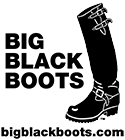
|
WESCO Boot Features
|

|
Lacing Patterns for Wesco Lace-up boots
Wesco lace-up boots are available with three kinds of lacing patterns. These lacing patterns influence both the number of lacing eyelets below the lacing hooks and the way the boots are sewn together in the foot.
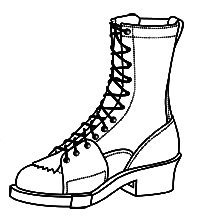 |
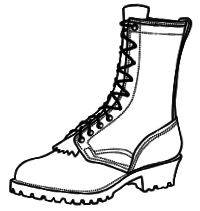 |
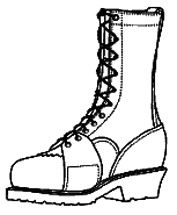 |
|
Lace-to-toe can't use safety toe |
Regular Toe optional safety toe |
Semi-lace-to-toe optional safety toe |
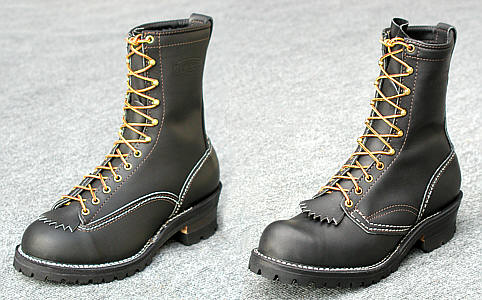
|
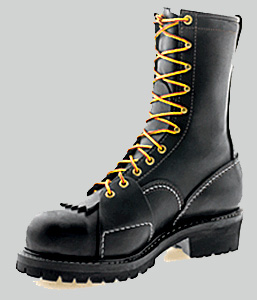
|
|
| Lace-to-toe | Regular Toe / Optional Safety Toe | Semi-Lace-to-toe / Optional Safety Toe |
The difference in the lacing styles lies in how far the lacing eyelets extend towards the toe and how the vamp or foot area is sewn.
The regular-toe style has 4 eyelets extending towards the toe from the botton lacing hook. The semi-lace-to-toe style has 5 eyelets and the lace-to-toe style has 6 eyelets.
The eyelets are spaced one inch (2.54 cm) apart. A 10 inch regular toe boot has 4 lacing eyelets at the toe, 5 lacing hooks going up the leg and a final lacing eyelet at the top. The 10 lacing positions, each one inch apart, give the boot it's 10 inch designation, but the boot is actually about 9 inches tall (measured up the inside back from the sole to the top). We have an FAQ article which goes into this issue in nauseating detail.
Safety toes are compatible with regular and semi-lace-to-toe styles but not with the lace-to-toe style.
Features of each lacing style:
- Regular Toe:
- 4 eyelets at the toe
- Safety toe compatible
- Seam where top attaches points down
- Fit of the toe not adjustable
- Semi-lace-to-toe:
- 5 eyelets at the toe
- Safety toe compatible
- Seam where top attaches points up
- Fit of the toe slightly adjustable
- Lace-to-toe:
- 6 eyelets at the toe
- Not Safety toe compatible
- Seam where top attaches points up
- Fit of the toe more adjustable
The issue with the way the top attaches is important in that the regular toe boot seam points down, as you can see in the above photos, and it will tend to snag on short sticks or branches pointing up from the ground. The lace-to-toe and semi-lace-to-toe styles have the seam where the top joins pointing upwards. That means that branches or sticks will slide past the seam without snagging.
Types of Leather for Wesco Boots
Wesco's standard leather used for their stock boots and as the default leather for custom boots is their Full Grain, 7 Ounce / 2.8 mm thick, oil tanned leather. This means that the entire thickness of the leather is used and the outside finish of the boots is the natural grain of the leather... not some plastic coating. Other, cheaper boots are made with split leather which is half the thickness or less and has been plated... painted with an artificial surface finish to imitate the grain of natural leather and to hide imperfections.
The painted surface of cheaper boots is one of the reasons that many of these cheaper boots make your feet feel hot and sweaty when you wear them. The painted surface keeps the leather from breathing.
Wesco's optional, extra cost leathers are mostly full grained Leathers but are lighter weight and have various surface treatments to achieve a shiny or silky or matte surface with various colors.
Consider choosing the Black Oil Tanned leather with a matte finish if you don't need a high shine and prefer to just oil/grease your boots to maintain the matte finish and get excellent breathability.
Boots made with the heavy weight Oil Tanned leathers have a dull, oily/waxy natural leather finish. The color is dyed deeply into leather, not just painted on. Oil tanned leather is meant to be oiled/greased to maintain water resistance and its excellent breathability. We feel it's superior to GoreTex® in breathability and water resistance. Oil tanned leather is not intended to be shined but can be with some effort. If shined it will still be water resistant but will loose much of its breathability. In order to shine oil tanned leather, you first have to remove the oil from the surface by washing several times with glycerin based saddle soap.
-
Heavy Weight Oil Tanned Leathers - 7 Ounce / 2.8 mm:
- - Black Oil Tanned
- - Brown Oil Tanned
- - Redwood Oil Tanned
-
Heavy Weight Oil Tanned Leather - 6.5 - 7 Ounce / 2.7 mm:
-
- Black Pebble: pebble grain finish
This is an oil tanned leather. It can be shined if you first wash the surface several times with glycerin saddle soap to remove the oil. It takes a great shine when polished with standard shoe polish and will be water resistant when polished.
-
Medium Weight Leathers - 5.5 - 6 Ounce / 2.3 mm:
-
Available Colors and Surface Textures:
- Black Tie Domain: silky black - takes a great shine
- Burgundy Domain: silky dark reddish brown - great shineThese are leathers with a dry, silky finish which can either be polished or oiled. The surface finish has special properties which cause stress and stretch in the leather to show. This give the leather more character and depth.
They take a great shine when polished with standard shoe polish and will be water resistant when polished.
They can also be oiled and will then take on the properties of the oil-tanned leathers. They will then have more of a matte finish with a dull sheen.
-
Lighter Weight Leather:
-
- Burlap Explorer: 5 - 5.5 oz / 2.1 mm - light tan leather with a dry, matte finish
Suitable for desert boots and typically used with the rough side out.
Normally not oiled or polished. -
Discontinued Leathers:
- As of August 2017 - -
Navy Blue Leather -
Brown Domain Leather -
Bright Red Leather -
Olive Leather -
Slate Leather -
Vegetable tanned Leather -
BKF - Black Silicon Tanned Fire Resistant LeatherThe BKF leather is no longer available. It has been replaced by the standard black oil-tanned leather which now also meets the specifications for fire resistant leather.
These leathers have an oily matte finish. They're designed to be oiled or greased to maintain water resistance and breathability. They're not intended to be shined but can be if desired. They're difficult to shine/polish until oil is removed from the leather by washing with glycerin saddle soap.
The Black version of these leathers now meets NFPA standards for fire and water resistance
These are the standard leathers used to build Wesco boots and the ones we highly recommend. They are available in black, brown and redwood colors. These are Full Grain, Oil-Tanned, Heavy (7 Ounce / 2.8mm) leathers with a natural surface grain free from the plating (paint job) used on cheaper leathers. This leather is strong and supple. It has a flat / matte finish. It doesn't shine when buffed. It is highly water resistant when kept oiled and breathes well in a manner similar to but better than Goretex... air and internal moisture breathes out through the leather but the oil keeps water from getting in.
Consider choosing Oil Tanned leather with a matte finish if you don't need a high shine and prefer to just oil/grease your boots to maintain the matte finish and get excellent breathability. You should also wash the boots occasionally with glycerine saddle soap. When boots are muddy, rinse the mud off before removing your boots. As the mud dries is will soak up the oil and dry the leather.
Boots made with the heavy weight Oil Tanned leathers have a dull, oily/waxy natural leather finish. The color is dyed deeply into leather, not just painted on. Oil tanned leather is meant to be oiled/greased to maintain water resistance and its excellent breathability. We feel it's superior to GoreTex® in breathability. Oil tanned leather is not intended to be shined but can be with some effort. If shined it will still be water resistant but will loose much of its breathability.
This leather has very good water resistance and can be kept that way by oiling with products such as Wesco Bee Oil or Obenauf's leather preservative. These are traditional care products made of oil and beeswax. They're available as an oil and a heavy grease. The oil-tanned leathers are designed to be oiled to achieve the best combination of breathability, water resistance and durability and to maintain their supple feel.
To shine oil tanned leather, you first have to remove the oil from the surface by washing several times with glycerin based saddle soap. Once polished, the leather will not breath as well.
The oil tanned leather is available in the standard Black and the optional Redwood and Brown colors. This is the standard leather used to build Wesco boots and is the leather traditionally used to build the legendary logger boots worn in the Pacific NorthWest rain forests of the USA and Canada.
Leather Colors for Wesco Boots
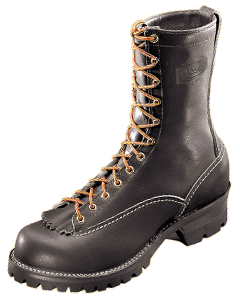 |
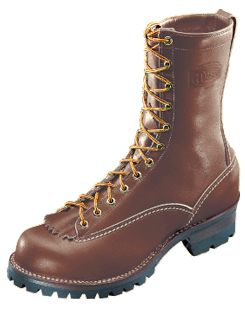 |
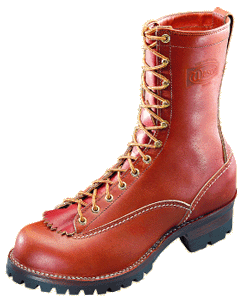 |
| Black | Brown | Redwood |
Wesco boots are typically made with heavy oil tanned leathers. Above are boots made in black, brown and redwood oil tanned leather. The boots in the picture were buffed to make them slightly shinier, but the leather usually has a slightly more matte or dull finish because of the oil in the leather.
The brown oil tanned leather will look darker when oiled and get a bit lighter as the leather becomes drier. It has great depth and character and will present a range of appearances as the character and color of the light changes.
The redwood oil tanned leather will vary slightly in color from one hide to another. Sometimes it is slightly more red and at other times more tan. The amount of oil on the leather makes a considerable difference in color. More oil makes the leather darker and more red while the leather gets lighter and more tan as it becomes dry.
Below are photos of the Wesco leathers to show their color and texture. The first photo minimizes reflections to show the color although the Burgundy and Black Tie samples still show a bit of sparkle from their surface texture. The second photo is taken at an angle to illustrate the amount of shine each leather exhibits.
Note that the colors presented here
are affected by your browser software, computer monitor, display card,
room lighting and the web author's heavy hand with the photo editor.
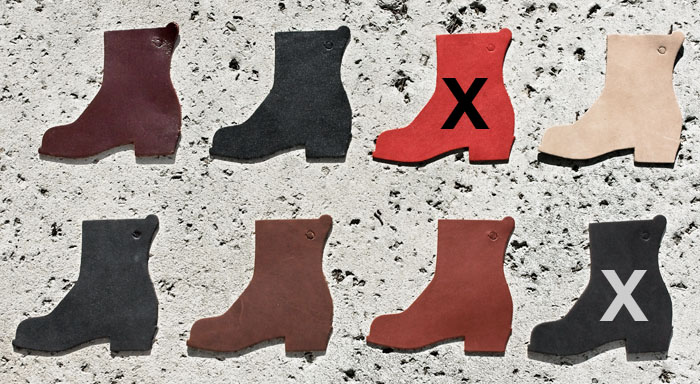
Top row: Burgundy, Black Tie, Bright
Red, Burlap Explorer
Bottom Row: Black, Brown, Redwood, BKF silicon tanned Black Fire resist
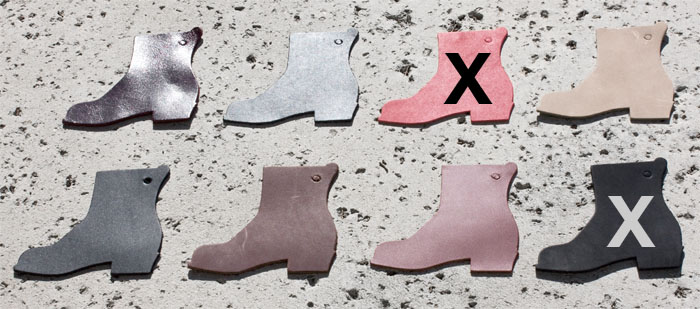
False Tongue / Kilty
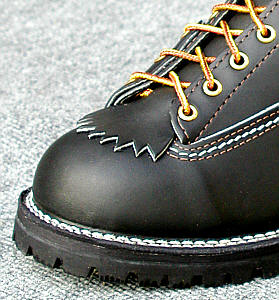 The false tongue or kilty is
an 8" (20 Cm) strip of leather with a
serrated edge at the bottom which is held in place by the bootlace as
it passes through the bottom eyelets.
The false tongue or kilty is
an 8" (20 Cm) strip of leather with a
serrated edge at the bottom which is held in place by the bootlace as
it passes through the bottom eyelets.
The false tongue comes standard on all lace-up Wesco boots. Whether you use it is up to you. Either you lace it in when you install the laces or you leave it out.
Some people swear by them and think they are the epitome of the logger / lineman boot. Others think they make the boots look like golf shoes. That said, you won't see many loggers in the North West forests of the US wearing their boots without them
They were originally intended to provide padding between the
bootlaces and the instep of
the foot in logger boots. This was necessary in boots which used thin
leather for the tongue
and also protected the tongue from wear by the laces.
Wesco uses thick, supple leather in the fully gusseted tongue, so the
false tongue
is not as necessary. It is a traditional complement to the boot.
Wildland Fire Protective Footwear - Wesco Firestormer Boots
These Wesco wildland fire boots are stocked in 10" heights in
the lace to toe
configuration in sizes 6 through 12 + 13 in D & E widths.
These Firestormer boots may also be custom ordered with
regular toes and
steel toes and in a wider range of sizes and heights.
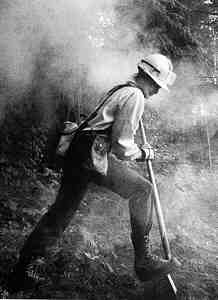 Why
have Wesco boots been a favorite for wildland fire fighting for
over 88 years? All models of Wesco boots are constructed of high
quality, heavy duty
materials. These boots take the traditional Wesco Jobmaster logger
design and
update it with features suited to wildland firefighting. This includes
the use of
the new heavy duty BKF silicon tanned black leather which has been
selected for excellent fire and
water resistance. The boots are sewn with black Kevlar®
thread. The boots
have an OrthoLite insole with Drilex lining for superior breathability
and comfort.
Why
have Wesco boots been a favorite for wildland fire fighting for
over 88 years? All models of Wesco boots are constructed of high
quality, heavy duty
materials. These boots take the traditional Wesco Jobmaster logger
design and
update it with features suited to wildland firefighting. This includes
the use of
the new heavy duty BKF silicon tanned black leather which has been
selected for excellent fire and
water resistance. The boots are sewn with black Kevlar®
thread. The boots
have an OrthoLite insole with Drilex lining for superior breathability
and comfort.
The special heavy duty fire-resistant #100F Vibram lug soles and heels are not just glued on, they are also sewn with heavy black fire resistant Kevlar thread. Wesco has one of the few boot soling machines which can sew through this many layers of thick leather and Vibram lug sole to make sure the soles stay on. The midsoles and inner soles of these boots are made of high quality leather instead of the synthetic materials typically used in cheaper boots. If synthetic materials were used they could melt when exposed to heat. This often occurs with cheap imitation logger boots. The lacing eyelets are made of heavy duty solid brass and the lacing hooks are built from machined solid brass studs. Finally, the boots come with black leather laces which resist fire damage, are easy on the hands when you lace the boots and easy to find when you need replacements.
These Firestormer / Jobmaster boots were born sturdy!
Wesco boots have been worn by Wildland Fire Fighters since 1918.
Fire Departments and Forestry organizations should contact us
for quantity pricing:
![]()
Although some organizations purchase boots for their crews, supplying boots is usually an individual responsibility... so you may want to be prepared in advance of signing up for fire duty. The National Interagency Fire Center says that boots are considered "personal gear".
We're often asked if the Highliner lineman, Jobmaster logger or Boss engineer boots are suitable for wildland fire fighting.. The answer is that these boots are built in the same way as the Firestormer boots. However they lack the specialized features which the Firestormer has: the more fire-resistant BKF leather, fire-resistant #100F Vibram soles and Kevlar thread. You can design your own custom Wesco fire boots by specifying the BKF leather, #100F Vibram soles and Kevlar thread as options.
The U.S. Forest Service Health and Safety Code Handbook (FSH 6709.11) Section 25.12 specifies the requirements for Personal Protective Equipment (PPE) to be worn by personnel engaged in wildland firefighting. Here's the requirement it sets for the boots firefighters must provide:
"Boots. Wear heavy-duty, leather, laced boots with nonskid soles and tops at least 8 inches (204 mm) high. Steel-toed (metal cup) footwear is not recommended for fire suppression."
So any lace-up Wesco boot with Vibram lug soles will meet these requirements but the Firestormer has been specifically designed and optimized for wildland fire fighting.
Wesco Heels
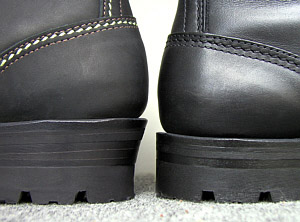
Most Wesco boots are made with a stacked logger
heel which is undercut in the back. The term "stacked" describes the
construction
of the heel which is composed of several layers of tapered leather and
rubber. The bootmakers call these tapered layers of leather "lifts"
because they lift the heel and make it higher.
This higher heel with the undercut back is used on logger boots worn by forestry workers so it is often called a "logger heel".
The height of this standard logger heel with Vibram #100 heavy lug soles is 2" / 51mm thick at the highest part of the heel. The sole under the foot of the boots is approximately 7/8" / 22mm thick.
This standard logger heel on Wesco Boss, Jobmaster and Highliner boots has three leather lifts in the sole. The Wesco Harness boots have four lifts.
On many Wesco boot styles you can get lower heels by specifying the option for one or two heel lifts lower. These "lifts" are the tapered leather layers in heel. Each lift makes the heel ¼" higher.
Removing two lifts (two lifts lower) makes your heels ½" / 13mm lower which is the same as a standard low heel on most boots.
This picture shows the standard stacked logger heel on the left and the lower regular heel on the right. Both boots shown have the Vibram #100 heavy lug soles. The boot on the left is a Wesco Jobmaster logger boot... the boot on the right is a Wesco Combat Boot.
However there is a consequence when boots are made with fewer lifts in the heel. This changes the angle of the entire sole and causes the boot shaft to lean backwards. If the boots are made "one lift lower", Wesco still uses the standard last but the boot shafts have a slight lean backwards.
The last is the special wooden form on which the boots are built and from which they take their shape. But when the boots are made with heels 2 lifts lower, it is necessary to switch to special versions of the lasts designed for lower heels.
Wesco builds fewer boots with lower heels so they don't have as extensive a collection of lasts in this design. The extra large and small sizes and extra wide widths are not available. Below are tables which show the range of sizes for Wesco boots made with each type of last they use.
Experience with the lasts used for the lower heel boots shows us that these lasts tend to be a bit larger than the standard lasts used for the stacked logger heel boots, so you should order boots made with the low heel about a half size smaller than you would order for the standard boots. So, if your foot measured 10½ D you would order size 10½ D Wesco boots with the standard logger heel, but you would order size 10 D if you had the boots made with this optional ½ inch lower heel.
US Men's Sizes Possible with Low Heels - 1½" / 38mm
| 4 | ½ | 5 | ½ | 6 | ½ | 7 | ½ | 8 | ½ | 9 | ½ | 10 | ½ | 11 | ½ | 12 | ½ | 13 | ½ | 14 | 15 | ||
| AAA | • | • | • | • | • | • | • | • | • | • | • | • | • | • | • | • | • | • | • | • | • | AAA | |
| AA | • | • | • | • | • | • | • | • | • | • | • | • | • | • | • | • | • | • | • | • | • | AA | |
| A | • | • | • | • | • | • | • | • | • | • | • | • | • | • | • | • | • | • | • | • | • | A | |
| B | • | • | • | • | • | • | • | • | • | • | • | • | • | • | • | • | • | • | • | • | • | B | |
| C | • | • | • | • | • | • | • | • | • | • | • | • | • | • | • | • | • | • | • | • | • | C | |
| D | • | • | • | • | • | • | • | • | • | • | • | • | • | • | • | • | • | • | • | • | • | D | |
| E | • | • | • | • | • | • | • | • | • | • | • | • | • | • | • | • | • | • | • | • | • | • | E |
| EE | • | • | • | • | • | • | • | • | • | • | • | • | • | • | • | EE | |||||||
| EEE | • | • | • | • | • | • | • | • | • | • | • | • | • | • | • | EEE | |||||||
| 4 | ½ | 5 | ½ | 6 | ½ | 7 | ½ | 8 | ½ | 9 | ½ | 10 | ½ | 11 | ½ | 12 | ½ | 13 | ½ | 14 | 15 |
Boots with low heels can be made in any size / width combination shown in green.
US Men's Sizes Possible with Standard Logger Heels - 2" / 50mm
| 2 | ½ | 3 | ½ | 4 | ½ | 5 | ½ | 6 | ½ | 7 | ½ | 8 | ½ | 9 | ½ | 10 | ½ | 11 | ½ | 12 | ½ | 13 | ½ | 14 | ½ | 15 | ½ | 16 | ½ | 17 | ½ | 18 | ½ | 19 | ½ | ||
| AAA | • | • | • | • | • | • | • | • | • | • | • | • | • | • | • | • | • | • | • | • | • | • | • | AAA | |||||||||||||
| AA | • | • | • | • | • | • | • | • | • | • | • | • | • | • | • | • | • | • | • | • | • | • | • | • | • | AA | |||||||||||
| A | • | • | • | • | • | • | • | • | • | • | • | • | • | • | • | • | • | • | • | • | • | • | • | • | • | • | A | ||||||||||
| B | • | • | • | • | • | • | • | • | • | • | • | • | • | • | • | • | • | • | • | • | • | • | • | • | • | • | B | ||||||||||
| C | • | • | • | • | • | • | • | • | • | • | • | • | • | • | • | • | • | • | • | • | • | • | • | • | • | • | • | C | |||||||||
| D | • | • | • | • | • | • | • | • | • | • | • | • | • | • | • | • | • | • | • | • | • | • | • | • | • | • | • | • | • | D | |||||||
| E | • | • | • | • | • | • | • | • | • | • | • | • | • | • | • | • | • | • | • | • | • | • | • | • | • | • | • | • | E | ||||||||
| EE | • | • | • | • | • | • | • | • | • | • | • | • | • | • | • | • | • | • | • | • | • | • | • | • | • | EE | |||||||||||
| EEE | • | • | • | • | • | • | • | • | • | • | • | • | • | • | • | • | • | • | • | • | • | • | • | • | • | EEE | |||||||||||
| 2 | ½ | 3 | ½ | 4 | ½ | 5 | ½ | 6 | ½ | 7 | ½ | 8 | ½ | 9 | ½ | 10 | ½ | 11 | ½ | 12 | ½ | 13 | ½ | 14 | ½ | 15 | ½ | 16 | ½ | 17 | ½ | 18 | ½ | 19 | ½ |
Boots with logger heels can be made in any size / width combination shown in green.
US Men's Sizes Possible with traditional #9109 "bump" toe last - heel 2" / 50mm
| 2 | ½ | 3 | ½ | 4 | ½ | 5 | ½ | 6 | ½ | 7 | ½ | 8 | ½ | 9 | ½ | 10 | ½ | 11 | ½ | 12 | ½ | 13 | ½ | 14 | ½ | 15 | ½ | 16 | ½ | 17 | ½ | 18 | ½ | 19 | ½ | ||
| AAA | • | • | • | • | AAA | ||||||||||||||||||||||||||||||||
| AA | • | • | • | • | AA | ||||||||||||||||||||||||||||||||
| A | • | • | • | • | • | • | • | • | • | • | • | • | • | • | • | • | • | • | • | • | • | A | |||||||||||||||
| B | • | • | • | • | • | • | • | • | • | • | • | • | • | • | • | • | • | • | • | • | • | B | |||||||||||||||
| C | • | • | • | • | • | • | • | • | • | • | • | • | • | • | • | • | • | • | • | • | • | C | |||||||||||||||
| D | • | • | • | • | • | • | • | • | • | • | • | • | • | • | • | • | • | • | • | • | • | D | |||||||||||||||
| E | • | • | • | • | • | • | • | • | • | • | • | • | • | • | • | • | • | • | • | • | • | • | • | E | |||||||||||||
| EE | • | • | • | • | • | • | • | • | • | • | • | • | • | • | • | • | • | • | • | • | • | • | • | EE | |||||||||||||
| EEE | • | • | • | • | • | • | • | • | • | • | • | • | • | • | • | • | • | • | • | • | • | EEE | |||||||||||||||
| 2 | ½ | 3 | ½ | 4 | ½ | 5 | ½ | 6 | ½ | 7 | ½ | 8 | ½ | 9 | ½ | 10 | ½ | 11 | ½ | 12 | ½ | 13 | ½ | 14 | ½ | 15 | ½ | 16 | ½ | 17 | ½ | 18 | ½ | 19 | ½ |
Boots with logger heels and the "old" #9109 last can be made in any size / width combination shown in green.
US Men's Sizes Possible with square toe boots - heel 2¼" / 57mm
| 2 | ½ | 3 | ½ | 4 | ½ | 5 | ½ | 6 | ½ | 7 | ½ | 8 | ½ | 9 | ½ | 10 | ½ | 11 | ½ | 12 | ½ | 13 | ½ | 14 | ½ | 15 | ½ | 16 |
½ | 17 |
½ | 18 |
½ | 19 |
½ | ||
| AAA | AAA | ||||||||||||||||||||||||||||||||||||
| AA | AA | ||||||||||||||||||||||||||||||||||||
| A | • | • | • | A | |||||||||||||||||||||||||||||||||
| B | • | • | • | • | • | • | • | • | • | • | • | • | • | • | B | ||||||||||||||||||||||
| C | • | • | • | • | • | • | • | • | • | • | • | • | • | • | • | • | • | C | |||||||||||||||||||
| D | • | • | • | • | • | • | • | • | • | • | • | • | • | • | • | D | |||||||||||||||||||||
| E | • | • | • | • | • | • | • | • | • | • | • | • | E | ||||||||||||||||||||||||
| EE | • | • | • | • | • | • | • | • | • | • | • | • | • | EE | |||||||||||||||||||||||
| EEE | • | EEE | |||||||||||||||||||||||||||||||||||
| 2 | ½ | 3 | ½ | 4 | ½ | 5 | ½ | 6 | ½ | 7 | ½ | 8 | ½ | 9 | ½ | 10 | ½ | 11 | ½ | 12 | ½ | 13 | ½ | 14 | ½ | 15 | ½ | 16 |
½ | 17 |
½ | 18 |
½ | 19 |
½ |
Boots with the square toe "harness boot" last can be made in any size / width combination shown in green.
BIG BLACK BOOTS Home Page
Email questions or comments to
![]()
Last edited 27 August, 2018 at 22:52 GMT